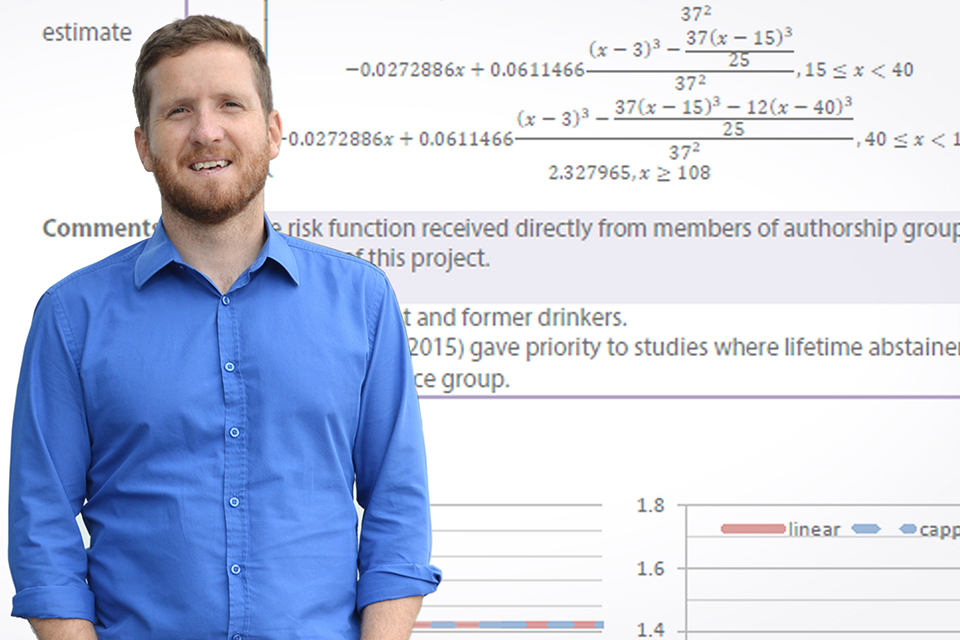PhD student develops a program to help researchers calculate alcohol-related harms
- Amanda Farrell-Low

How much does alcohol cost? Think beyond the price of a bottle of wine; how many deaths per year are due to alcohol-related colon cancer? How about hospitalizations due to impaired driving accidents?
Estimating these larger costs related to alcohol use involves a lot of complex calculations, which means a lot of time and effort. This is why Adam Sherk, a PhD student and research associate with UVic’s Canadian Institute for Substance Use Research (CISUR), developed the International Model of Alcohol Harms and Policies, or InterMAHP.
Sherk got the idea for InterMAHP when he noticed that CISUR was handling several projects that involved estimating the harms caused by alcohol—in particular, around hospital visits and fatalities that could be attributed to drinking.
My idea was to automate and standardize some of the complex methodologies behind these estimates, while at the same time providing a flexible tool that countries and provinces can use to study the alcohol harms in their region.
—Adam Sherk, PhD student and research associate
InterMAHP, which is free to download and comes with an extensive user manual, allows researchers, policymakers and others to calculate something called an alcohol-attributable fraction, or AAF. Sherk points to the example of liver cirrhosis, a condition often associated with alcohol use.
“Some but not all of the cases of liver cirrhosis in a population occur because people are drinking alcohol,” he explains. “But what percentage is caused by alcohol drinking? Is it 25 per cent, 50 per cent or 75 per cent?”
Here’s how the tool can help determine that. InterMAHP makes use of region-specific data around alcohol consumption and drinking patterns, as well as for 40 alcohol-related health conditions (everything from certain types of cancer to car accidents), sorted by gender and age.
InterMAHP can then calculate what percentage of harms in a region are due to alcohol (the AAF)—calculations that used to take weeks. InterMAHP also offers some consistency in how these values are calculated. The AAF can then be used to figure out how much a government is spending on alcohol-related hospital visits per year.
To develop the tool, Sherk worked with CISUR director Tim Stockwell and programmer John Dorocicz, as well as Jürgen Rehm and Kevin Shield from the Centre for Addiction and Mental Health, who are responsible for producing the World Health Organization’s Global Status Reports on Alcohol and Health and Global Burden of Disease (of alcohol) studies.
Sherk and others are already applying InterMAHP on a global scale. Sherk will be attending three international alcohol research conferences this year. The tool is currently being used on alcohol policy projects in Finland and Sweden, as well as for two provincial projects (in BC and Quebec) and for a national study estimating the harms of substance use in Canada.
Other jurisdictions are starting to use it, too; InterMAHP is being used to drive the relative risk estimation in the US Center for Disease Control and Prevention’s Alcohol-Related Disease Impact online tool.
“We’re very fortunate to have a doctoral candidate of Adam’s calibre dedicating his studies to the development of this valuable resource,” says Stockwell. “InterMAHP is a wonderful example of the kind of interdisciplinary and applied research that UVic’s Social Dimensions of Health program was set up to accomplish.
“Adam is combining his background and skills in economics, mathematics and public health to create a world-class resource that will contribute to improved global health and safety.”
Learn more about InterMAHP.
Photos
In this story
Keywords: alcohol, addiction, health, graduate research, Canadian Institute for Substance Use Research
People: Adam Sherk
Publication: The Ring





